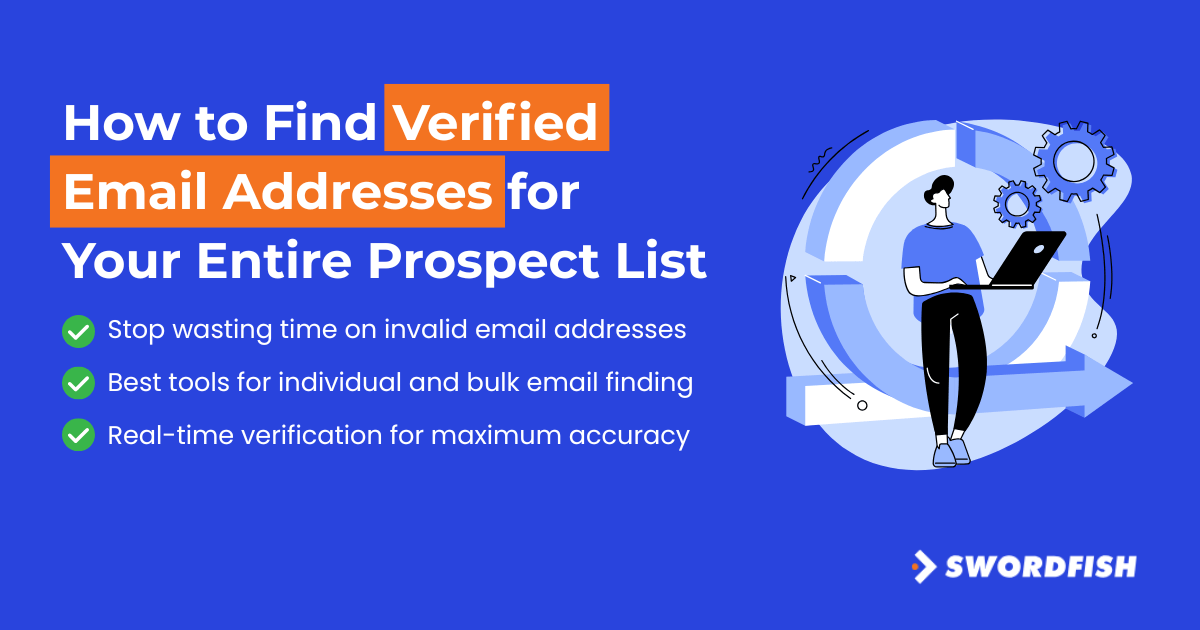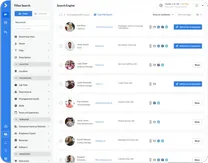
Finding verified email addresses at scale remains critical for B2B success in 2025, but many teams still face challenges with accuracy and deliverability. With email deliverability rates averaging 98.16% this year, using unverified contacts can still damage your sender reputation and lower engagement. This guide covers proven methods to find and verify email addresses for entire prospect lists, compares top platforms like ZoomInfo vs alternatives (Apollo.io, Lusha, Hunter.io, Bouncer, ZeroBounce), and highlights cost-effective solutions for businesses of all sizes.
Introduction:
Finding verified email addresses for your entire prospect list shouldn’t feel like searching for needles in a haystack. Yet, according to recent Salesforce research, 79% of B2B marketers struggle with email deliverability due to poor data quality. This challenge directly impacts results: in 2024, marketing emails had an average deliverability rate of just 83.1%, meaning nearly 1 in 6 emails never even reached their intended recipient. Whether you’re a recruiter trying to reach passive candidates, a sales rep chasing quota, or a marketer building campaigns, having accurate, verified contact data is the foundation of success.
The challenge isn’t just finding email addresses, it’s finding the right ones that actually reach your prospects’ inboxes. In this comprehensive guide, we’ll walk through proven strategies, compare leading platforms, and share actionable tips to build high-quality prospect lists that drive real results.
Why Email Verification Matters More Than Ever
Before diving into how to find verified email addresses, let’s address the elephant in the room: why verification is non-negotiable in 2025.
Here’s what happens when you skip verification:
Impact on Deliverability
Email deliverability rates below 80% are considered poor, while rates above 95% are considered excellent. When you send emails to invalid addresses, mailbox providers notice. They track your bounce rates, spam complaints, and engagement metrics to determine whether your future emails deserve inbox placement or should be relegated to spam folders.
Sender Reputation Damage
Every bounced email is a black mark against your domain’s reputation. Internet service providers use sophisticated algorithms to evaluate sender credibility, and consistent bounces from unverified addresses can quickly land you on blocklists that are difficult to escape.
Wasted Resources
Beyond deliverability concerns, unverified lists waste time, money, and effort. Your sales team spends valuable hours crafting personalized outreach messages that will never be seen. Your marketing budget gets consumed by contacts who can’t receive your communications.
Email deliverability rates have dropped significantly over the past two years. According to Mailchimp’s 2024 Email Marketing Benchmarks, the average B2B email deliverability rate sits at just 81.4% – meaning nearly 1 in 5 emails never reach their intended recipient.
The solution? Build verification into your prospecting workflow from day one.
The Complete Guide to Finding Verified Email Addresses
Method 1: Advanced Boolean Search Techniques
Start with what’s freely available. Advanced Google searches can uncover email patterns and contact information that many teams overlook.
Power Search Operators:
- site:company.com “email” OR “@” – Find email patterns on company websites
- “John Smith” AND company.com filetype:pdf – Locate contacts in published documents
- “John Smith” + company + contact OR email – Broad contact discovery
LinkedIn X-Ray Searches: Combine LinkedIn with Google to find professional emails: site:linkedin.com/in “VP Sales” “San Francisco” “SaaS”
While free searches help with individual contacts, they’re not scalable for entire prospect lists. For volume prospecting, you’ll need dedicated tools.
Method 2: Email Finding & Verification Platforms
The market offers dozens of email finding tools, but they’re not created equal. Let’s examine the leading options:
Apollo.io: The All-in-One Approach
Apollo.io has gained popularity as a comprehensive sales platform, combining prospecting, engagement, and CRM functionality. With over 210 million contacts in their database, Apollo serves as many teams’ primary prospecting hub.
Apollo.io Strengths:
- Extensive B2B database with firmographic data
- Built-in email sequencing and dialing
- Native CRM integrations
- Competitive pricing starting at $49/user/month
Apollo.io’s Main Limitations:
However, Apollo.io users frequently encounter several key challenges that drive them to seek Apollo’s alternatives:
- Data Accuracy Concerns: Multiple user reports indicate email accuracy rates around 70-75%, below industry leading standards
- Limited Phone Data: Particularly weak for cell phone numbers and direct dials
- Verification Gaps: Real-time email verification isn’t their strongest feature
- International Coverage: Primarily US-focused data, with limited European/APAC contacts
- Compliance Issues: Some users report GDPR compliance concerns
Method 3: Specialized Contact Intelligence Platforms
For teams requiring higher accuracy rates and more comprehensive contact data, specialized platforms often deliver superior results.
ZoomInfo vs Apollo.io for Enterprise Teams
ZoomInfo positions itself as the enterprise standard for B2B contact intelligence:
- Database Size: 100+ million professional profiles with deep firmographic data
- Accuracy: Industry-leading email accuracy rates (85-90%+)
- Intent Data: Powerful buyer intent signals for prioritizing prospects
- Enterprise Features: Advanced analytics, team collaboration, and sophisticated integrations
The Trade-off: ZoomInfo’s enterprise focus comes with enterprise pricing—typically $15,000+ annually for meaningful access.
Cognism offers middle-ground positioning between Apollo and ZoomInfo:
- Global Reach: Strong European and international data coverage
- Compliance Focus: GDPR-compliant data collection and processing
- Phone-First Approach: Excellent for teams prioritizing cold calling
- Custom Pricing: Typically ranges from $5,000-$12,000 annually
When to Choose ZoomInfo/Cognism Over Apollo:
- Enterprise sales teams with substantial budgets
- International prospecting requirements
- Teams requiring highest possible data accuracy
- Organizations with strict compliance needs
Method 4: Cost-Effective Alternatives for Small Businesses
Not every team has enterprise budgets. Here are the best Apollo.io alternatives for smaller organizations:
Hunter.io: The Email Specialist
Pricing: Starting at $49/month for 1,000 searches
Best For: Teams focused purely on email finding and verification
In our Hunter.io review, we find that it excels at what it does: finding and verifying professional email addresses. Their Chrome extension makes individual prospecting effortless, while bulk features handle list building at scale.
Key Features:
- Pattern-based email finding
- Real-time verification
- Email deliverability confidence scores
- Domain-wide contact discovery
Lusha: The Sales-Friendly Option
Pricing: Starting at $39/user/month
Best For: Small sales teams needing email + phone data
Lusha strikes a balance between functionality and affordability, offering both email addresses and phone numbers through an intuitive interface.
Lusha Strengths:
- Robust LinkedIn integration
- Access to mobile and direct dial phone numbers
- User-friendly Chrome extension
- Affordable pricing for smaller teams
Key Limitations:
- Limited features for bulk prospecting
- A smaller database compared to enterprise platforms
- Credit-based pricing can become costly at scale
Swordfish.ai: The Accuracy Leader
For teams prioritizing data accuracy and real-time verification, Swordfish.ai offers unique advantages:
Key Differentiators:
- 200+ live data partners for comprehensive coverage
- Real-time email and phone verification before you spend credits
- Cell phone accuracy that consistently outperforms competitors
- Unlimited plans starting at $99/month for solo users
- No geographic restrictions – access global contact data
Swordfish particularly excels for recruiting teams, with customers reporting 400% more cleared candidates and 1,000+ hours saved in sourcing time.
Free vs Paid Email Finding Solutions
Best Free Apollo.io Alternatives
While free tools can’t match paid platforms’ database depth, they’re valuable for individual prospecting and small-scale needs:
- LinkedIn Sales Navigator Free Trial: 30-day access to advanced search filters
- Hunter.io Free Plan: 25 searches per month with verification
- Voila Norbert Free Credits: 50 free email searches monthly
- FindThatEmail: 10 free searches daily
- Google Advanced Search: Always free, requires manual effort
Free Tool Strategy: Use free trials and credits for initial testing, then invest in paid solutions once you validate your prospecting approach.
When to Upgrade to Paid Solutions
Consider paid platforms when you experience:
- Volume needs: Searching 100+ contacts monthly
- Accuracy requirements: Need 90%+ email deliverability
- Time constraints: Manual prospecting takes too long
- Team scaling: Multiple users need access
- Integration needs: Connecting to CRM or automation tools
Lead Generation and Email Outreach: Platform Comparisons
Different platforms excel in different areas. Understanding whether you need lead generation, email outreach, or both determines the best platform choice.
Pure Lead Generation: ZoomInfo vs Swordfish.ai
Characteristics:
- Emphasis on data breadth and search functionality
- Advanced filtering and segmentation
- Real-time data enrichment
- Higher data accuracy rates
ZoomInfo dominates for comprehensive lead generation with:
- Advanced technographic and firmographic filters
- Intent data for timing outreach
- Extensive company intelligence
- Enterprise-grade list building
Swordfish.ai excels for high-accuracy contact discovery:
- Real-time verification reduces bounce rates
- Superior cell phone data for multi-channel outreach
- Bulk enrichment for existing prospect lists
- API access for custom integrations
Email Outreach Capabilities
Characteristics:
- Integrated email sequence automation
- Campaign performance tracking
- A/B testing capabilities
- CRM synchronization
Apollo.io: Built-in email sequences and automation make it a one-stop solution for smaller teams.
Specialized Tools: For advanced email marketing, dedicated platforms like Outreach, SalesLoft, or HubSpot typically offer superior deliverability and analytics.
Best Practice: Many successful teams use specialized finders (like Swordfish.ai) for prospecting, then export to dedicated outreach platforms for email campaigns.
Advanced Strategies for Enterprise Prospect Lists
Multi-Source Data Approach
Enterprise teams often combine multiple platforms for maximum coverage:
- Primary Database: ZoomInfo or Apollo for initial prospecting
- Verification Layer: Swordfish.ai or Hunter.io for email validation
- Phone Enhancement: Specialized tools for mobile numbers
- Social Intelligence: LinkedIn Sales Navigator for relationship mapping
Automated List Building Workflows
Set up systematic processes for continuous prospect list growth:
Weekly Routine:
- Export new leads from primary database
- Run bulk verification on all email addresses
- Append phone numbers using secondary tools
- Upload verified contacts to CRM
- Trigger automated outreach sequences
Quality Control Checklist:
- Email addresses verified within 30 days
- Phone numbers tested for connectivity
- Company information current and accurate
- Duplicates removed across all sources
- GDPR/CCPA compliance verified for all contacts
Email Verification Best Practices
Real-Time vs Batch Verification
Real-Time Verification: Verify emails as you find them
- Pros: Immediate feedback, prevents bad data entry
- Cons: Slower prospecting, higher per-search costs
- Best For: Individual prospecting, high-value targets
Batch Verification: Upload entire lists for bulk verification
- Pros: Cost-effective for large lists, faster processing
- Cons: Delayed feedback, some verified emails may decay
- Best For: Marketing campaigns, large-scale outreach
Verification Accuracy Metrics to Track
Monitor these key metrics to optimize your email verification process:
- Bounce Rate: Should be under 2% with proper verification
- Deliverability Rate: Target 95%+ for verified lists
- Response Rate: Improved verification should boost engagement
- Sender Reputation: Monitor your domain’s email reputation score
Compliance and Legal Considerations
GDPR and International Prospecting
When building international prospect lists, ensure your chosen platform handles compliance appropriately:
Key Requirements:
- Lawful basis for processing personal data
- Clear opt-out mechanisms in all outreach
- Data retention and deletion policies
- Vendor compliance with regional regulations
Platform Considerations:
- Swordfish.ai: GDPR compliant, excludes EU-based individuals from standard searches
- Cognism: Built specifically with European compliance in mind
- ZoomInfo: Enterprise-grade compliance features and legal team support
- Apollo.io: Basic compliance features, may require additional legal review
CAN-SPAM and Email Marketing Laws
Regardless of your platform choice, ensure all outreach complies with:
- Clear sender identification
- Truthful subject lines
- Physical address inclusion
- One-click unsubscribe options
- Prompt opt-out processing (10 business days max)
ROI Calculation: Choosing the Right Platform
Cost-Per-Verified-Contact Analysis
Calculate true platform costs using this framework:
Total Monthly Cost ÷ Verified Contacts Generated = Cost Per Verified Contact
Example comparison:
- Apollo.io: $100/month ÷ 400 verified contacts = $0.25 per contact
- Hunter.io: $50/month ÷ 150 verified contacts = $0.33 per contact
- Swordfish.ai: $99/month ÷ 500 verified contacts = $0.20 per contact
Revenue Impact Calculation
Measure platform ROI by tracking downstream metrics:
Revenue Per Contact = (Deals Closed × Average Deal Size) ÷ Total Contacts Reached
If better verification increases your email response rate from 3% to 5%, the revenue impact can be substantial:
- 1,000 contacts × 5% response rate = 50 conversations
- 1,000 contacts × 3% response rate = 30 conversations
- 66% more conversations from improved data quality
Building Your Email Verification Workflow
Step-by-Step Implementation
Week 1-2: Platform Selection and Setup
- Sign up for free trials of 2-3 platforms
- Test with a sample of 50-100 prospects
- Compare accuracy, usability, and integration options
- Select primary platform and backup options
Week 3-4: Process Development
- Create standardized prospecting templates
- Establish verification requirements and quality metrics
- Set up CRM integrations and data flow
- Train team members on new tools and processes
Month 2+: Optimization and Scaling
- Monitor key metrics and adjust processes
- A/B test different prospecting approaches
- Scale successful workflows across team
- Regularly audit data quality and compliance
Integration with Existing Tools
Most email verification platforms offer robust integration options:
CRM Integration: Salesforce, HubSpot, Pipedrive sync for seamless data flow
Email Platforms: Connect to Mailchimp, Constant Contact, or Outreach for automated list building
Chrome Extensions: One-click prospecting while browsing LinkedIn, company websites, or industry directories
Conclusion: Your Next Steps to Verified Email Success
Learning how to find verified email addresses at scale is a game-changer for any B2B team. The key is combining the right tools with systematic processes and quality control measures.
Quick Action Plan:
- Audit your current process: Calculate your cost-per-verified-contact and bounce rates
- Test 2-3 platforms: Use free trials to compare accuracy and usability
- Start with verification: Even if you keep your current finder, add real-time verification
- Monitor and optimize: Track metrics and continuously improve your approach
Remember, the best email finding platform is the one that consistently delivers verified, actionable contacts for your specific use case and budget. Whether you choose Apollo.io, ZoomInfo, Hunter.io, or Swordfish.ai, the key is implementing systematic verification and maintaining data quality standards.
Ready to find verified email addresses that actually reach your prospects? Try Swordfish.ai for free and discover why teams achieve 90%+ email accuracy with our real-time verification platform.
About the Author
Ben Argeband is the Founder and CEO of Swordfish.ai and Heartbeat.ai. With deep expertise in data and SaaS, he has built two successful platforms trusted by over 50,000 sales and recruitment professionals. Ben’s mission is to help teams find direct contact information for hard-to-reach professionals and decision-makers, providing the shortest route to their next win. Connect with Ben on LinkedIn.
Frequently Asked Questions
How accurate are email finding tools?
Accuracy varies significantly by platform. Industry leaders like ZoomInfo and Swordfish.ai achieve 85-90%+ accuracy, while others may deliver 70-75%. Always verify emails before sending campaigns.
Can I use multiple email finding platforms together?
Yes, many teams use 2-3 platforms for maximum coverage. Use a primary database for volume prospecting, then verify contacts through a specialized verification service.
How often should I re-verify email addresses?
Email addresses decay at roughly 2-3% monthly. Re-verify contacts every 3-6 months, or before major campaigns.
Are there free alternatives to paid email finding tools?
Free tools like Hunter.io’s free plan or Google searches can help with individual prospecting, but paid platforms are essential for scalable, accurate prospecting.
How do I stay compliant when prospecting internationally?
Choose platforms with built-in compliance features, understand local regulations (GDPR, CCPA, CAN-SPAM), and always provide clear opt-out options in your outreach.


 View Products
View Products



